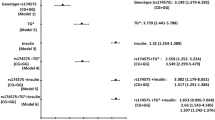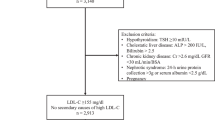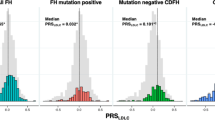Abstract
Objective:
Familial combined hyperlipidemia (FCH) is characterized by elevated levels of total cholesterol (TC), triglycerides (TG) and apolipoprotein B (apo B) and is associated with premature cardiovascular disease (CVD). Other features of FCH are obesity and insulin resistance. Serum leptin levels have also been associated with obesity, insulin resistance and atherosclerosis. Leptin exerts its effect through the leptin receptor (LEPR). The aim of this study is to determine whether the Gln223Arg polymorphism in the LEPR gene contributes to FCH and its associated phenotypes.
Methods:
The study population consists of 37 families, comprising 644 subjects, of whom 158 subjects were diagnosed as FCH. The FCH diagnosis was based on plasma TC and TG levels, adjusted for age and gender, and absolute apo B levels, according to our recently published nomogram. The Gln223Arg polymorphism was studied by restriction fragment length polymorphism-PCR.
Results:
Carriers of one or two Arg alleles had an increased risk of FCH, compared to subjects homozygous for the Gln allele (OR=1.6 [95% CI 1.0–2.4]). A difference in high-density lipoprotein cholesterol (HDL-c) levels was present between carriers and non-carriers of an Arg allele, 1.21 vs 1.28 mmol/l, respectively (P=0.04), but no differences in obesity, insulin resistance and other lipid parameters were found.
Conclusion:
The Gln223Arg polymorphism in the LEPR gene is associated with FCH, which is supported by a significant association between HDL-c levels and the LEPR gene.
This is a preview of subscription content, access via your institution
Access options
Subscribe to this journal
Receive 12 print issues and online access
$259.00 per year
only $21.58 per issue
Buy this article
- Purchase on Springer Link
- Instant access to full article PDF
Prices may be subject to local taxes which are calculated during checkout
Similar content being viewed by others
References
Hopkins PN, Heiss G, Ellison RC, Province MA, Pankow JS, Eckfeldt JH et al. Coronary artery disease risk in familial combined hyperlipidemia and familial hypertriglyceridemia: a case–control comparison from the National Heart, Lung, and Blood Institute Family Heart Study. Circulation 2003; 108: 519–523.
Austin MA, McKnight B, Edwards KL, Bradley CM, McNeely MJ, Psaty BM et al. Cardiovascular disease mortality in familial forms of hypertriglyceridemia: a 20-year prospective study. Circulation 2000; 101: 2777–2782.
Bredie SJ, Kiemeney LA, de Haan AF, Demacker PN, Stalenhoef AF . Inherited susceptibility determines the distribution of dense low-density lipoprotein subfraction profiles in familial combined hyperlipidemia. Am J Hum Genet 1996; 58: 812–822.
Bredie SJ, Demacker PN, Stalenhoef AF . Metabolic and genetic aspects of familial combined hyperlipidaemia with emphasis on low-density lipoprotein heterogeneity. Eur J Clin Invest 1997; 27: 802–811.
de Graaf J, Stalenhoef AF . Defects of lipoprotein metabolism in familial combined hyperlipidaemia. Curr Opin Lipidol 1998; 9: 189–196.
Castro CM, de Bruin TW, de Valk HW, Shoulders CC, Jansen H, Willem ED . Impaired fatty acid metabolism in familial combined hyperlipidemia. A mechanism associating hepatic apolipoprotein B overproduction and insulin resistance. J Clin Invest 1993; 92: 160–168.
de Graaf J, Veerkamp MJ, Stalenhoef AF . Metabolic pathogenesis of familial combined hyperlipidaemia with emphasis on insulin resistance, adipose tissue metabolism and free fatty acids. J R Soc Med 2002; 9 (Suppl 42): 46–53.
de Graaf J, van der Vleuten G, Stalenhoef AF . Diagnostic criteria in relation to the pathogenesis of familial combined hyperlipidemia. Semin Vasc Med 2004; 4: 229–240.
Shoulders CC, Jones EL, Naoumova RP . Genetics of familial combined hyperlipidemia and risk of coronary heart disease. Hum Mol Genet 2004; 13 (Spec No 1): R149–R160.
Hoffer MJ, Bredie SJ, Boomsma DI, Reymer PW, Kastelein JJ, de KP et al. The lipoprotein lipase (Asn291 → Ser) mutation is associated with elevated lipid levels in families with familial combined hyperlipidaemia. Atherosclerosis 1996; 119: 159–167.
Hoffer MJ, Snieder H, Bredie SJ, Demacker PN, Kastelein JJ, Frants RR et al. The V73M mutation in the hepatic lipase gene is associated with elevated cholesterol levels in four Dutch pedigrees with familial combined hyperlipidemia. Atherosclerosis 2000; 151: 443–450.
Mar R, Pajukanta P, Allayee H, Groenendijk M, linga-Thie G, Krauss RM et al. Association of the APOLIPOPROTEIN A1/C3/A4/A5 gene cluster with triglyceride levels and LDL particle size in familial combined hyperlipidemia. Circ Res 2004; 94: 993–999.
Bredie SJ, Vogelaar JM, Demacker PN, Stalenhoef AF . Apolipoprotein E polymorphism influences lipid phenotypic expression, but not the low density lipoprotein subfraction distribution in familial combined hyperlipidemia. Atherosclerosis 1996; 126: 313–324.
Pei W, Baron H, Muller-Myhsok B, Knoblauch H, Al Yahyaee SA, Hui R et al. Support for linkage of familial combined hyperlipidemia to chromosome 1q21–q23 in Chinese and German families. Clin Genet 2000; 57: 29–34.
Coon H, Myers RH, Borecki IB, Arnett DK, Hunt SC, Province MA et al. Replication of linkage of familial combined hyperlipidemia to chromosome 1q with additional heterogeneous effect of apolipoprotein A-I/C-III/A-IV locus. The NHLBI Family Heart Study. Arterioscler Thromb Vasc Biol 2000; 20: 2275–2280.
Pajukanta P, Nuotio I, Terwilliger JD, Porkka KV, Ylitalo K, Pihlajamaki J et al. Linkage of familial combined hyperlipidaemia to chromosome 1q21–q23. Nat Genet 1998; 18: 369–373.
Pajukanta P, Lilja HE, Sinsheimer JS, Cantor RM, Lusis AJ, Gentile M et al. Familial combined hyperlipidemia is associated with upstream transcription factor 1 (USF1). Nat Genet 2004; 36: 371–376.
Allayee H, Krass KL, Pajukanta P, Cantor RM, van der Kallen CJ, Mar R et al. Locus for elevated apolipoprotein B levels on chromosome 1p31 in families with familial combined hyperlipidemia. Circ Res 2002; 90: 926–931.
van der Kallen CJ, Cantor RM, van Greevenbroek MM, Geurts JM, Bouwman FG, Aouizerat BE et al. Genome scan for adiposity in Dutch dyslipidemic families reveals novel quantitative trait loci for leptin, body mass index and soluble tumor necrosis factor receptor superfamily 1A. Int J Obes Relat Metab Disord 2000; 24: 1381–1391.
Norman RA, Tataranni PA, Pratley R, Thompson DB, Hanson RL, Prochazka M et al. Autosomal genomic scan for loci linked to obesity and energy metabolism in Pima Indians. Am J Hum Genet 1998; 62: 659–668.
Lammert A, Kiess W, Bottner A, Glasow A, Kratzsch J . Soluble leptin receptor represents the main leptin binding activity in human blood. Biochem Biophys Res Commun 2001; 283: 982–988.
Quinton ND, Smith RF, Clayton PE, Gill MS, Shalet S, Justice SK et al. Leptin binding activity changes with age: the link between leptin and puberty. J Clin Endocrinol Metab 1999; 84: 2336–2341.
Zhang Y, Proenca R, Maffei M, Barone M, Leopold L, Friedman JM . Positional cloning of the mouse obese gene and its human homologue. Nature 1994; 372: 425–432.
Halaas JL, Gajiwala KS, Maffei M, Cohen SL, Chait BT, Rabinowitz D et al. Weight-reducing effects of the plasma protein encoded by the obese gene. Science 1995; 269: 543–546.
Jequier E . Leptin signaling, adiposity, and energy balance. Ann N Y Acad Sci 2002; 967: 379–388.
Sinha MK, Opentanova I, Ohannesian JP, Kolaczynski JW, Heiman ML, Hale J et al. Evidence of free and bound leptin in human circulation. Studies in lean and obese subjects and during short-term fasting. J Clin Invest 1996; 98: 1277–1282.
Kieffer TJ, Heller RS, Habener JF . Leptin receptors expressed on pancreatic beta-cells. Biochem Biophys Res Commun 1996; 224: 522–527.
Muoio DM, Dohm GL, Fiedorek Jr FT, Tapscott EB, Coleman RA, Dohn GL . Leptin directly alters lipid partitioning in skeletal muscle. Diabetes 1997; 46: 1360–1363.
Shimabukuro M, Koyama K, Chen G, Wang MY, Trieu F, Lee Y et al. Direct antidiabetic effect of leptin through triglyceride depletion of tissues. Proc Natl Acad Sci USA 1997; 94: 4637–4641.
Chagnon YC, Wilmore JH, Borecki IB, Gagnon J, Perusse L, Chagnon M et al. Associations between the leptin receptor gene and adiposity in middle-aged Caucasian males from the HERITAGE family study. J Clin Endocrinol Metab 2000; 85: 29–34.
Quinton ND, Lee AJ, Ross RJ, Eastell R, Blakemore AI . A single nucleotide polymorphism (SNP) in the leptin receptor is associated with BMI, fat mass and leptin levels in postmenopausal Caucasian women. Hum Genet 2001; 108: 233–236.
Rosmond R, Chagnon YC, Holm G, Chagnon M, Perusse L, Lindell K et al. Hypertension in obesity and the leptin receptor gene locus. J Clin Endocrinol Metab 2000; 85: 3126–3131.
Ogawa T, Hirose H, Yamamoto Y, Nishikai K, Miyashita K, Nakamura H et al. Relationships between serum soluble leptin receptor level and serum leptin and adiponectin levels, insulin resistance index, lipid profile, and leptin receptor gene polymorphisms in the Japanese population. Metabolism 2004; 53: 879–885.
Heo M, Leibel RL, Boyer BB, Chung WK, Koulu M, Karvonen MK et al. Pooling analysis of genetic data: the association of leptin receptor (LEPR) polymorphisms with variables related to human adiposity. Genetics 2001; 159: 1163–1178.
Gotoda T, Manning BS, Goldstone AP, Imrie H, Evans AL, Strosberg AD et al. Leptin receptor gene variation and obesity: lack of association in a white British male population. Hum Mol Genet 1997; 6: 869–876.
Veerkamp MJ, de Graaf J, Bredie SJ, Hendriks JC, Demacker PN, Stalenhoef AF . Diagnosis of familial combined hyperlipidemia based on lipid phenotype expression in 32 families: results of a 5-year follow-up study. Arterioscler Thromb Vasc Biol 2002; 22: 274–282.
Veerkamp MJ, de Graaf J, Hendriks JC, Demacker PN, Stalenhoef AF . Nomogram to diagnose familial combined hyperlipidemia on the basis of results of a 5-year follow-up study. Circulation 2004; 109: 2980–2985.
Demacker PN, Hijmans AG, Vos-Janssen HE, van’t Laar A, Jansen AP . A study of the use of polyethylene glycol in estimating cholesterol in high-density lipoprotein. Clin Chem 1980; 26: 1775–1779.
Demacker PN, Veerkamp MJ, Bredie SJ, Marcovina SM, de Graaf J, Stalenhoef AF . Comparison of the measurement of lipids and lipoproteins versus assay of apolipoprotein B for estimation of coronary heart disease risk: a study in familial combined hyperlipidemia. Atherosclerosis 2000; 153: 483–490.
de Graaf J, Swinkels DW, de Haan AF, Demacker PN, Stalenhoef AF . Both inherited susceptibility and environmental exposure determine the low-density lipoprotein-subfraction pattern distribution in healthy Dutch families. Am J Hum Genet 1992; 51: 1295–1310.
Stalenhoef AF, de Graaf J, Wittekoek ME, Bredie SJ, Demacker PN, Kastelein JJ . The effect of concentrated n-3 fatty acids versus gemfibrozil on plasma lipoproteins, low density lipoprotein heterogeneity and oxidizability in patients with hypertriglyceridemia. Atherosclerosis 2000; 153: 129–138.
Swinkels DW, Hak-Lemmers HL, Demacker PN . Single spin density gradient ultracentrifugation method for the detection and isolation of light and heavy low density lipoprotein subfractions. J Lipid Res 1987; 28: 1233–1239.
de Galan BE, Tack CJ, Lenders JW, Pasman JW, Elving LD, Russel FG et al. Theophylline improves hypoglycemia unawareness in type 1 diabetes. Diabetes 2002; 51: 790–796.
Matthews DR, Hosker JP, Rudenski AS, Naylor BA, Treacher DF, Turner RC . Homeostasis model assessment: insulin resistance and beta-cell function from fasting plasma glucose and insulin concentrations in man. Diabetologia 1985; 28: 412–419.
van der Vleuten GM, Veerkamp MJ, van Tits LJH, Toenhake H, den Heijer M, Stalenhoef AFH et al. Elevated leptin levels in subjects with familial combined hyperlipidemia are associated with the increased risk for CVD. Atherosclerosis 2005; 183 (2): 355–360.
Ukkola O, Tremblay A, Despres JP, Chagnon YC, Campfield LA, Bouchard C . Leptin receptor Gln223Arg variant is associated with a cluster of metabolic abnormalities in response to long-term overfeeding. J Intern Med 2000; 248: 435–439.
Wauters M, Mertens I, Rankinen T, Chagnon M, Bouchard C, Van Gaal L . Leptin receptor gene polymorphisms are associated with insulin in obese women with impaired glucose tolerance. J Clin Endocrinol Metab 2001; 86: 3227–3232.
Takahashi-Yasuno A, Masuzaki H, Miyawaki T, Ogawa Y, Matsuoka N, Hayashi T et al. Leptin receptor polymorphism is associated with serum lipid levels and impairment of cholesterol lowering effect by simvastatin in Japanese men. Diabetes Res Clin Pract 2003; 62: 169–175.
Heo M, Leibel RL, Fontaine KR, Boyer BB, Chung WK, Koulu M et al. A meta-analytic investigation of linkage and association of common leptin receptor (LEPR) polymorphisms with body mass index and waist circumference. Int J Obes Relat Metab Disord 2002; 26: 640–646.
Mammes O, Aubert R, Betoulle D, Pean F, Herbeth B, Visvikis S et al. LEPR gene polymorphisms: associations with overweight, fat mass and response to diet in women. Eur J Clin Invest 2001; 31: 398–404.
Matsuoka N, Ogawa Y, Hosoda K, Matsuda J, Masuzaki H, Miyawaki T et al. Human leptin receptor gene in obese Japanese subjects: evidence against either obesity-causing mutations or association of sequence variants with obesity. Diabetologia 1997; 40: 1204–1210.
Wauters M, Considine RV, Chagnon M, Mertens I, Rankinen T, Bouchard C et al. Leptin levels, leptin receptor gene polymorphisms, and energy metabolism in women. Obes Res 2002; 10: 394–400.
Nishina PM, Lowe S, Wang J, Paigen B . Characterization of plasma lipids in genetically obese mice: the mutants obese, diabetes, fat, tubby, and lethal yellow. Metabolism 1994; 43: 549–553.
Liang CP, Tall AR . Transcriptional profiling reveals global defects in energy metabolism, lipoprotein, and bile acid synthesis and transport with reversal by leptin treatment in ob/ob mouse liver. J Biol Chem 2001; 276: 49066–49076.
Mendez-Sanchez N, Gonzalez V, King-Martinez AC, Sanchez H, Uribe M . Plasma leptin and the cholesterol saturation of bile are correlated in obese women after weight loss. J Nutr 2002; 132: 2195–2198.
Soro A, Jauhiainen M, Ehnholm C, Taskinen MR . Determinants of low HDL levels in familial combined hyperlipidemia. J Lipid Res 2003; 44: 1536–1544.
Babirak SP, Brown BG, Brunzell JD . Familial combined hyperlipidemia and abnormal lipoprotein lipase. Arterioscler Thromb 1992; 12: 1176–1183.
Kullo IJ, Turner ST, Boerwinkle E, Kardia SL, de AM . A novel quantitative trait locus on chromosome 1 with pleiotropic effects on HDL-cholesterol and LDL particle size in hypertensive sibships. Am J Hypertens 2005; 18: 1084–1090.
Acknowledgements
We thank Rogier Veltrop for his contribution to the genotyping and Mario J Veerkamp for her contribution to the collection of the samples.
Author information
Authors and Affiliations
Corresponding author
Rights and permissions
About this article
Cite this article
van der Vleuten, G., Kluijtmans, L., Hijmans, A. et al. The Gln223Arg polymorphism in the leptin receptor is associated with familial combined hyperlipidemia. Int J Obes 30, 892–898 (2006). https://doi.org/10.1038/sj.ijo.0803234
Received:
Revised:
Accepted:
Published:
Issue Date:
DOI: https://doi.org/10.1038/sj.ijo.0803234
Keywords
This article is cited by
-
Gene polymorphisms associated with non-alcoholic fatty liver disease and coronary artery disease: a concise review
Lipids in Health and Disease (2016)
-
Novel locus for fibrinogen in 3′ region of LEPR gene in island population of Vis (Croatia)
Journal of Human Genetics (2014)
-
Leptin, leptin gene and leptin receptor gene polymorphism in heart failure with preserved ejection fraction
Heart and Vessels (2012)
-
Functional Consequences of the Human Leptin Receptor (LEPR) Q223R Transversion
Obesity (2009)
-
Association between variants in the genes for leptin, leptin receptor, and proopiomelanocortin with chronic heart failure in the Czech population
Heart and Vessels (2009)



